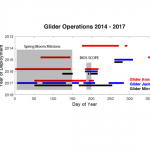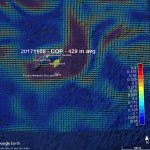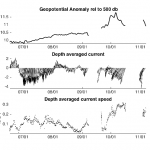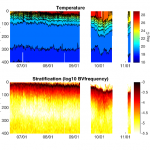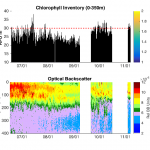Jack is soloing in the water at the BATS site this fall after a very full Winter–Summer Field Campaign from Jan through July. The timeline for glider deployments (Fig. 1) depicts the significant ramp up of activities associated with the Spring Bloom and BIOS-SCOPE missions in 2017.
Post-processing and quality assurance of the full datasets is nearly complete and these are available as matlab files. A netCDF version for post-processed data and a web portal are being developed. Beginning this July, real-time data were uploaded on a daily basis to the U.S. IOOS Glider Data Assembly Center (DAC) for dissemination via GTS.
The summer glider schedule was marked by a number of unanticipated events. Jack was deployed June 28, but had to be recovered on July 28 following a suspected shark attack in which his tail rudder was lost. He was back in the water on Sept 20, but lost his port wing (another biological interaction???) and was recovered on Oct 16. The glider was re-deployed on Nov 3 and will remain in the water until late December.
The figures show Jack’s track line and present location and the ocean currents, sea surface height, temperature and stratification measured by BIOS gliders at the BATS site from June to November. As usual, the summer season was characterized by increasing near-surface stratification and declining plankton biomass in the nutrient-depleted photic zone. Biological production picked up slightly in October as seasonal winds strengthened, the surface waters cooled, and the mixed layer began to deepen.
Meanwhile back in the MAGIC Lab, our other 2 gliders, Anna and Minnie, are awaiting new science bays while their original sensors are being re-calibrated at the factory. The plan is to deploy them in December – Minnie carrying the SUNA sensor and Anna with a PAR (Photsynthetically Available Radiance) sensor to measure profiles of nutrient concentrations and light levels respectively. We also anticipate adding a microstructure package this spring to the trio of gliders to generate much-needed profiles of velocity and vertical shear to our broadening set of observations. These newest sensors will enable us to differentiate the processes that mix nutrients up into the photic zone (e.g. convective, shear and baroclinic instabilities), and place needed constraints on the amounts of nutrients and particulate carbon exchanged between the shallow and deeper layers.
- Timeline of glider missions since the inception of the MAGIC Program.
- Jack’s location relative to surface currents (from Copernicus model) on 07-Nov-2017. Very strong southwestward currents are sweeping through the BATS area, and mark the boundary between two counter-rotating eddies.
- Dynamic sea surface height (geopotential anomaly, GPA) and depth averaged currents. Strong currents are associated with fronts on the edge of eddies, such as the anticyclone (peak GPA) in early October. This feature contributed to abnormally high tides (> 2 ft above average) on the island.
- Time series of temperature and vertical stratification show the evolution of the upper 400 meter water column from summer to fall
- Time series of chlorophyll inventory and optical backscatter, proxies for phytoplankton biomass, show declines through the summer months followed by an increase in late September and early October as the surface stratification began to ebb and deepen.


